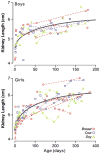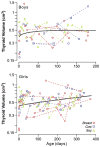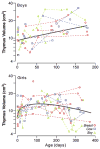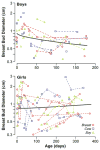US assessment of estrogen-responsive organ growth among healthy term infants: piloting methods for assessing estrogenic activity
- PMID: 21104239
- PMCID: PMC3141824
- DOI: 10.1007/s00247-010-1895-0
US assessment of estrogen-responsive organ growth among healthy term infants: piloting methods for assessing estrogenic activity
Abstract
Background: A mother's circulating estrogen increases over the third trimester, producing physiological effects on her newborn that wane postnatally. Estrogenization might be prolonged in newborns exposed to exogenous estrogens, such as isoflavones in soy formula.
Objective: We evaluated ultrasonography for monitoring growth of multiple estrogen-responsive organs in healthy infants and developed organ-growth trajectories.
Materials and methods: We studied 38 boys (61 visits) from birth to age 6 months and 41 girls (96 visits) from birth to age 1 year using a partly cross-sectional, partly longitudinal design. We measured uterus and ovaries in girls, testes and prostate in boys, and kidneys, breasts, thymus, and thyroid in all children. We imaged all organs from the body surface in one session of < 1 h.
Results: Uterine volume decreased from birth (P < 0.0001), whereas ovarian volume increased sharply until age 2 months and then decreased (P < 0.001). Testicular volume increased with age (P < 0.0001), but prostatic volume showed minimal age trend. Breast bud diameter showed no age trend in girls but declined from birth in boys (P = 0.03).
Conclusion: US examination of multiple estrogen-responsive organs in infants in a single session is feasible and yields volume estimates useful for assessing potential endocrine disruptor effects on organ growth.
Figures








Similar articles
-
A Longitudinal Study of Estrogen-Responsive Tissues and Hormone Concentrations in Infants Fed Soy Formula.J Clin Endocrinol Metab. 2018 May 1;103(5):1899-1909. doi: 10.1210/jc.2017-02249. J Clin Endocrinol Metab. 2018. PMID: 29506126 Free PMC article.
-
Pilot studies of estrogen-related physical findings in infants.Environ Health Perspect. 2008 Mar;116(3):416-20. doi: 10.1289/ehp.10409. Environ Health Perspect. 2008. PMID: 18335112 Free PMC article.
-
Ultrasonographic patterns of reproductive organs in infants fed soy formula: comparisons to infants fed breast milk and milk formula.J Pediatr. 2010 Feb;156(2):215-20. doi: 10.1016/j.jpeds.2009.08.043. Epub 2009 Oct 21. J Pediatr. 2010. PMID: 19846109
-
Soy infant formula and phytoestrogens.J Paediatr Child Health. 2003 Aug;39(6):401-5. doi: 10.1046/j.1440-1754.2003.00178.x. J Paediatr Child Health. 2003. PMID: 12919490 Review.
-
Nutrition, growth, and allergic diseases among very preterm infants after hospital discharge.Dan Med J. 2013 Feb;60(2):B4588. Dan Med J. 2013. PMID: 23461996 Review.
Cited by
-
Sexual Dimorphism and the Origins of Human Spinal Health.Endocr Rev. 2018 Apr 1;39(2):221-239. doi: 10.1210/er.2017-00147. Endocr Rev. 2018. PMID: 29385433 Free PMC article. Review.
-
Prenatal Exposure to Endocrine Disruptors: A Developmental Etiology for Polycystic Ovary Syndrome.Reprod Sci. 2017 Jan;24(1):19-27. doi: 10.1177/1933719116654992. Epub 2016 Sep 27. Reprod Sci. 2017. PMID: 27342273 Free PMC article.
-
Biological Mechanisms of Polyphenols against Clostridium Difficile: A Systematic Review.Infect Disord Drug Targets. 2025;25(3):e18715265313944. doi: 10.2174/0118715265313944240726115600. Infect Disord Drug Targets. 2025. PMID: 39234903
-
A Longitudinal Study of Estrogen-Responsive Tissues and Hormone Concentrations in Infants Fed Soy Formula.J Clin Endocrinol Metab. 2018 May 1;103(5):1899-1909. doi: 10.1210/jc.2017-02249. J Clin Endocrinol Metab. 2018. PMID: 29506126 Free PMC article.
-
The Role of Polyphenols in Human Health and Food Systems: A Mini-Review.Front Nutr. 2018 Sep 21;5:87. doi: 10.3389/fnut.2018.00087. eCollection 2018. Front Nutr. 2018. PMID: 30298133 Free PMC article. Review.

